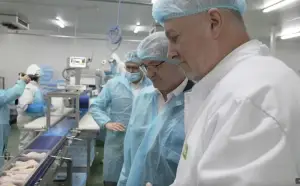- Serbia
Get to know Serbia
- Citizens
Culture and science
Health services
Pension and disability insurance
- Business
Employment
Economy
- Media
- Government
- Contact
Keep in touch
Contact form
Back
Keepin touch
Whether you have a question, comment, suggestion or any problem in the purview of the government, send us your message and we will try to respond as soon as possible. If your problem is not in our purview, we will forward your message to the relevant institution.
Q:
A:
January-June foreign trade volume jumps 32.8 percent year-on-year
Belgrade,
30 July 2004
Serbia’s foreign trade volume in January-June climbed 32.8 percent against the same period of 2003, to $6.41 billion, the statistics office said in a statement. When expressed in euros, the trade volume amounted to €5.23 billion, up 19.9 percent year-on-year.
Exports rose 11.5 percent, to $1.47 billion, while imports climbed 40.8 percent, to $4.94 billion. When expressed in euros, exports edged up 0.5 percent year-on-year, to €1.2 billion, while imports grew 27.2 percent, to €4.03 billion.
The January-June trade gap widened 58.5 percent, reaching $3.47 million. The deficit widened 43.4 percent when calculated in euros, to €2.83 billion.
Intermediate goods accounted for 67.1 percent of total exports, or $987.3 million, consumer goods for 25.6 percent, or $377.5 million, and equipment for 7.3 percent, or $106.8 million.
Intermediate goods made up 54.9 percent of overall imports, or $2.71 billion, followed by consumer goods, 25.4 percent, or $1.26 billion, and equipment, 19.7 percent, or $970.8 million.
The bulk of exports, $257 million, went to Bosnia-Herzegovina. Italy imported $175 million worth of Serbian goods, while $171 million went to Germany.
The majority of imports, $665 million, came from Russia. Germany also exported $665 million in goods to Serbia, while Italy’s exports reached $469 million.
Steel and iron accounted for $156 million of total exports, fruit and vegetables for $97 million, ferrous metals, $87 million, rubber products, $86 million, and miscellaneous manufactured articles, $83 million. The five sectors made up 34.6 percent of overall exports.
Oil and oil products accounted for $432 million of overall imports, road vehicles for $389 million, general industry machinery, $249 million, machinery specialized for particular industries, $205 million, and natural gas, $194 million. The five sectors made up 29.7 percent of total imports in January-June.
The January-June trade gap widened 58.5 percent, reaching $3.47 million. The deficit widened 43.4 percent when calculated in euros, to €2.83 billion.
Intermediate goods accounted for 67.1 percent of total exports, or $987.3 million, consumer goods for 25.6 percent, or $377.5 million, and equipment for 7.3 percent, or $106.8 million.
Intermediate goods made up 54.9 percent of overall imports, or $2.71 billion, followed by consumer goods, 25.4 percent, or $1.26 billion, and equipment, 19.7 percent, or $970.8 million.
The bulk of exports, $257 million, went to Bosnia-Herzegovina. Italy imported $175 million worth of Serbian goods, while $171 million went to Germany.
The majority of imports, $665 million, came from Russia. Germany also exported $665 million in goods to Serbia, while Italy’s exports reached $469 million.
Steel and iron accounted for $156 million of total exports, fruit and vegetables for $97 million, ferrous metals, $87 million, rubber products, $86 million, and miscellaneous manufactured articles, $83 million. The five sectors made up 34.6 percent of overall exports.
Oil and oil products accounted for $432 million of overall imports, road vehicles for $389 million, general industry machinery, $249 million, machinery specialized for particular industries, $205 million, and natural gas, $194 million. The five sectors made up 29.7 percent of total imports in January-June.
-
 Belgrade, 27 October 2025
Belgrade, 27 October 2025Construction of Selova dam of vital importance for southeast Serbia
-
 Belgrade, 22 October 2025
Belgrade, 22 October 2025First 19 resolutions awarded under IPARD III for procurement of new tractors
-
 Šid, 21 October 2025
Šid, 21 October 2025Superior Foods example of successful Serbia-Hungary cooperation
-
 Belgrade/Washington, 17 October 2025
Belgrade/Washington, 17 October 2025Confirmation of Serbia’s position as attractive investment destination
-
 Belgrade/Washington, 16 October 2025
Belgrade/Washington, 16 October 2025Serbian economy maintains stability amid global challenges
-
 Sombor, 14 October 2025
Sombor, 14 October 2025Agriculture one of major pillars of bilateral cooperation with Italy
-
 Belgrade, 13 October 2025
Belgrade, 13 October 2025First IPARD III resolutions on support to farmers presented
-
 Belgrade, 21 September 2025
Belgrade, 21 September 2025Solution for legalisation of 4.8 million properties by year’s end
-
 Belgrade, 19 September 2025
Belgrade, 19 September 2025Strong potential for Italian investments in Serbia’s processing sector
-
 Belgrade, 17 September 2025
Belgrade, 17 September 2025Serbia committed to building strong economic ties with Russia
